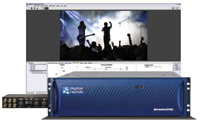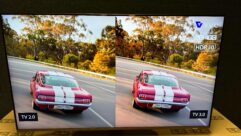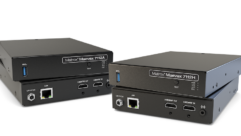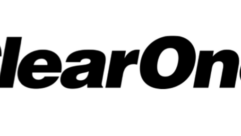

AV Streaming Devices Technology Showcase
Jan 11, 2011 12:00 PM,
By Mike McIntyre
Digital Rapids StreamZHD
It wasn’t too long ago that an article about AV streaming devices would have been very short and only contained some very expensive items. In fact, about five years ago, I was looking for a way to stream a live service from one church to another with good enough video quality to put it on a large projection screen. The only solution I found would have cost about $50,000—and that’s not counting what the network backbone would have cost. Fast-forward to now, and as you will see below, there have been some exciting developments. Everything from portable units that use 3G/4G cellular transmission to broadcast-quality H.264 encoders that can be viewed on desktops, proprietary decoders, and even your iPhone.
A four-time winner of the Readers’ Choice Awards from Streaming Media magazine, Digital Rapids offers a wide variety of solutions for live encoding, streaming, and archiving. In the company’s live encoder category, StreamZ and StreamZHD—which supports 720p, 1080i, and 1080p inputs and output resolutions up to 1920×1080—offer exceptional quality with many features. Not the least of these is a broad range of encoding formats to be viewed on devices as varied as IPTV set-top boxes and iPhones. All models may also be combined with Digital Rapids Broadcast Manager software for management, scheduling, and monitoring. In one box, you can capture, preprocess, encode, transcode, brand, protect, archive, and stream. An incredible set of tools for automation and integration such as RS-422 deck control, closed-caption support, GPI triggers, logging, email notification, FTP delivery, and DVD image creation allow the workflow to be organized and automated. Content protection options including YouTube Content ID and Vobile VideoDNA support—which generates fingerprints that allow automatic identification of clips on the Web—round out an encyclopedia of wonderful things these systems can do for you.
A standalone version in Digital Rapids’ live category is the TouchStream appliance. With a built-in monitor and touchscreen, it sets the standard for the one-box approach to live streaming. Applications including concerts, sporting events, newsgathering, corporate communications, and worship would be suitable venues for this device. Able to stream in multiple formats, resolutions, and bit rates simultaneously, TouchStream uses video noise reduction to minimize noise in video caused by low lighting and other conditions onsite.

Haivision Makito
Well-suited for multichannel enterprise IPTV delivery, schools, medical facilities, stadiums, auditoriums, professional training, and simulation environments is Makito from Haivision. Based on H.264 compression, it saves more than 50 percent of the bandwidth and disk space required by MPEG-2 IP video. Supporting HD up to 1080p (analog or digital), computer resolutions of up to 1920×1080 at full frame rate, or composite video, this product takes compatibility to a new level.
Furnace is an end-to-end solution for video over IP that provides a secure, simple-to-use and -deploy system for encoding and distributing live video to computers and set-top boxes. It features a zero-footprint InStream player to provide video directly to the desktop or dedicated displays using the Stingray set-top box. SD and HD H.264 video and MPEG-1, MPEG-2, MPEG-4 SD video may be distributed in both scenarios. A unique feature with this system is the ability to sync playback between the set-top boxes and the stream players, marrying the two delivery systems to the environment. HiLo streaming can simultaneously emit full HD bandwidth along with reduced resolutions giving users the flexibility to choose the resolution best suited to their needs and network capabilities.
With carrier-grade, low-latency video compression for IP transport incorporating full support for combined metadata applications, Piranha is perfect for applications such as intelligence, surveillance, reconnaissance (ISR); unmanned airborne vehicle (UAV); and key length value (KLV) systems. Based around Haivision’s MPEG-4 AVC H.264 compression engine, it combines all of the features of the Hai1000 with metadata captured from one of four serial port interfaces or extracted from the vertical blanking interval (line 21 or closed caption) data space and incorporates the data information in realtime.
AV Streaming Devices Technology Showcase
Jan 11, 2011 12:00 PM,
By Mike McIntyre

Matrox CompressHD

Matrox MXO2
Matrox has been a leader in computer video card technology for years. Matrox Max technology is continuing that legacy with H.264 encoding, decoding, and acceleration, and it is available on the Matrox CompressHD accelerator card and the Matrox MXO2 family of cards for PC and Mac. A vast array of tuneable controls for the H.264 encoding, such as speed, video quality, and noise filtering, make the technology extremely useful for video content publishers.
Mediasite, from Sonic Foundry, has been popular for years in colleges and corporate training environments because of its ability to synchronize a computer presentation with a camera and audio. Sonic Foundry describes its product offering for these systems in four parts: record, deliver, watch, and manage.
The Mediasite Recorder records in realtime and may be scheduled to automatically stop and start, and those presentations may be streamed live or viewed on demand. Next in line is the Mediasite EX Server, a powerful platform for delivering and managing the multimedia presentations from the recorder. It has the ability to schedule, secure, catalog, customize, integrate, and track recorded content. The latest changes to the “watch” part of the line include a reworking of the Mediasite Player, which now enables the viewer to customize their experience for more of a context-based viewing. Mediasite Catalog automatically publishes your recorded presentations to designated online catalogs for immediate viewing. Mediasite’s Scheduler allows you to designate recording dates and times, manage recurring presentations, and email event notifications.

Streambox Avenir
Streambox employs a similar approach to IP streaming as some of its close competitors, that of providing solutions for every part of the process. For encoding, the company offers Avenir, a new battery-powered mobile encoder that is able to encode HD/SD video and transmit over 3G and 4G cellular networks, making it a hot commodity for newsgathering, live sports, and emergency response. For SD encoding, the SBT3-2300 and SBT3-5300 offer features such as low end-to-end latency and advanced forward error correction. The SBT3-9300 allows for HD and SD video input with excellent video quality (HD from 512kbps to 30Mbps), as well as simultaneous output of HD and downconverted SD video from a single HD source. Also available are software encoders for Mac laptops.
The Distribution Server allows routing streams from multiple encoders to multiple decoders and locations, and the Broadcast Server works as a point-to-multipoint stream router, making it ideal for streaming to laptop and desktop clients.
AV Streaming Devices Technology Showcase
Jan 11, 2011 12:00 PM,
By Mike McIntyre
VBrick Systems describes its market position as filling the gap between consumer video and high-end studio broadcasting. The company’s approach to IP streaming is a complete end-to-end solution, which includes live capture, transport, play, record and store, manage and control, and unified communications.
First in live capture encoding appliances are the H.264 versions. Supporting everything from composite video to 3G-SDI, and scalable between SD and HD, these full-featured encoders unicast and multicast video streams to up to 25 unique destinations. They are fully integrated into the VEMS media management platform for live playback, recording, and video on demand. Next, the Windows Media Encoder has many of the same features including captioning support. For mission-critical deployments, the MPEG Encoder employs an integrated server that allows 200 simultaneous users directly from the appliance.
Rich Media Studio is an all-in-one device that captures and delivers live presentations and records them for on-demand playback over IP networks. With this device, you are able to input XGA/DVI, composite video, and audio and combine them into one stream. Lastly the VBrick Mobile Broadcasting System allows transmission over 3G and 4G cellular networks.
Under the transport section of VBrick’s product offerings is the WM Reflector appliance, which works as a bridge between a low-bandwidth bottleneck and a WAN. Hardware decoders and IP set-top boxes provide simple, cost-effective solutions for viewing streams.
For recording, all of the encoding devices may have optional drives added for direct-to-disc recording. The Network Video Recorder enables its users to record up to 40 simultaneous video streams from anywhere within its network at one time. An integrated component of the EtherneTV product family, the recorder is administered through a portal server, and it records H.264, Windows Media, MPEG-1, MPEG-2, and MPEG-4 video streams. VBrick’s VOD Server enables on-demand playback of your media anywhere on your network. A Windows Media and H.264 version give users the ability to choose their favored media playback method.
All these VBrick devices are controlled and monitored using the VEMS management software, which offers modules such as VEMS Presenter, VEMS Scheduler, and VEMS Channel Guide. The VEMS platform also integrates into the IBM Lotus Sametime unified communications and collaboration suite.
Small and packed with many of the same features found in the larger models, ViewCast’s Niagara 2100 offers a portable, low-cost streaming solution. Supporting multiple Windows Media streams simultaneously, this device is built on the prolific ViewCast Osprey technology. The built-in web interface allow simple setup control from anywhere on the network. With the streaming parameters set up, you can begin streaming in multiple resolutions and bit rates with a single button push on the front panel of the device. Its sister product, Niagara 2120, offers all the same features at the same price point, except its streaming engine supports Adobe Flash H.264.
AV Streaming Devices Technology Showcase
Jan 11, 2011 12:00 PM,
By Mike McIntyre

ViewCast Niagara 4100
Slightly larger than the 2100 series, the Niagara 4100 offers many more features including the ability to ingest HD video and digital (AES) audio, which makes this appliance ideal for live sports, newsgathering, or anywhere you need HD webcasting or streaming on the go. A, B, and C buttons on the front panel can activate three different streaming profiles. Using ViewCast’s SimulStream technology, the Niagara 4100 can simultaneously stream different data rates, resolutions, and formats, including MPEG-4, Adobe Flash H.264, Windows Media, and iPhone. Niagara GoStream Surf is similar to the 4100, except it inputs analog video instead of SD-HD/SDI.

ViewCast Niagara 7500
Like the 4100, the Niagara 7500 has the ability to ingest SD or HD video and digital audio, and on top of that supports switching on the fly between standard and high-definition sources without having to re-initialize the system. This 2RU appliance features the same type of simple intuitive front-panel controls as above and a small built-in video confidence monitor. Preprocessing features include closed-caption extraction and rendering, de-interlacing, inverse telecine, bitmap overlay, scaling, and cropping. Niagara SCX remote management software is included, and it is preloaded with a software development kit (SDK) that allows you to customize the software to your own workflow.
The Niagara 8224 will capture, encode, stream, and archive audio and video on eight fully independent channels at once. Using the Niagara SCX and SimulStream software, both preconfigured, you are ready to set up, control, and monitor the streaming system. You can create multiple streams in different formats in realtime and customize each with individual sizing and scaling, bitmap overlays, and closed-caption prerendering.
Two independent encoding channels allow you to capture SDI video and encode multiple full-resolution (D1) streams with the Niagara Pro II. Applications for this may be broadcasters, studios, enterprise IT departments, content delivery networks (CDNs), and network service providers. Like most of the other offerings from ViewCast, this will create multiple streams in different formats simultaneously.

ZeeVee Zv series
The last entry in the article may seem a little out of place because of its delivery method, but actually it makes perfect sense. ZeeVee uses coax wiring to distribute HD video in realtime. The ZvPro 280 ingests video resolutions up to 1920×1080 and uses MPEG-2 encoding and RF modulation to deliver the video as a QAM channel onto a display’s existing digital tuner. It even has a built-in spectrum analyzer to look for a vacant channel. Two other models, the ZvBox 170 and ZvBox 250, are less expensive versions that work the same way but offer lower resolutions or slightly different control options.










